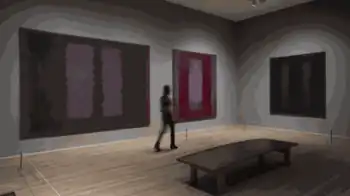
The Seagram murals are a series of paintings by Mark Rothko, his first to experiment with a dark palette. The paintings were originally commissioned for The Four Seasons Restaurant in New York City's Seagram Building. Rothko intended for the dark paintings to sicken the restaurant's patrons. After visiting the restaurant where his paintings were to hang, he cancelled and returned his first commission. The paintings were stored and later some were donated to the Tate. Rothko made 30 in the series in his lifetime.[1]
The paintings have been the subject of two documentaries and a play,[1] Red, by John Logan.[2] The paintings were defaced while hanging in the Tate Modern in 2012, for which a man received a two-year prison sentence.[3][4] The culprit, Vladimir Umanets, later expressed regret for vandalising the piece, and explained he had intended to make an artistic statement.[5]
References
- 1 2 Cain, Abigail (November 18, 2016). "Why One Meal Made Rothko Cancel His First Major Commission". Artsy. Archived from the original on November 27, 2016. Retrieved January 19, 2021.
- ↑ Michaud, Jon (April 1, 2010). "Rothko and the Four Seasons". The New Yorker. Archived from the original on December 24, 2020. Retrieved January 19, 2021.
- ↑ Quinn, Ben (October 7, 2012). "Rothko painting defaced at Tate Modern". The Guardian. Archived from the original on November 12, 2020. Retrieved January 19, 2021.
- ↑ Brown, Mark (December 13, 2012). "Man jailed for two years for vandalising £5m Rothko at Tate Modern". The Guardian. Archived from the original on November 11, 2020. Retrieved January 19, 2021.
- ↑ Umanets, Vladimir (May 15, 2014). "I regret vandalising a Rothko, but I remain committed to Yellowism". The Guardian. ISSN 0261-3077. Retrieved February 21, 2023.
Further reading
- Jones, Jonathan (December 7, 2002). "How Rothko's Seagram murals found their way to London". The Guardian. Archived from the original on October 25, 2020. Retrieved January 19, 2021.